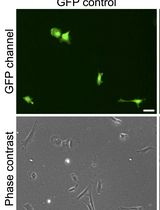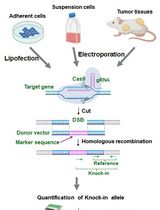- EN - English
- CN - 中文
A Fast and Efficient Decellularization Method for Tissue Slices
一种快速、高效的组织切片去细胞方法
发布: 2022年11月20日第12卷第22期 DOI: 10.21769/BioProtoc.4550 浏览次数: 2596
评审: Alessandro DidonnaEmilie ViennoisRAMESH KUDIRA
Abstract
The study and use of decellularized extracellular matrix (dECM) in tissue engineering, regenerative medicine, and pathophysiology have become more prevalent in recent years. To obtain dECM, numerous decellularization procedures have been developed for the entire organ or tissue blocks, employing either perfusion of decellularizing agents through the tissue’s vessels or submersion of large sections in decellularizing solutions. However, none of these protocols are suitable for thin tissue slices (less than 100 µm) or allow side-by-side analysis of native and dECM consecutive tissue slices. Here, we present a detailed protocol to decellularize tissue sections while maintaining the sample attached to a glass slide. This protocol consists of consecutive washes and incubations of simple decellularizing agents: ultrapure water, sodium deoxycholate (SD) 2%, and deoxyribonuclease I solution 0.3 mg/mL (DNase I). This novel method has been optimized for a faster decellularization time (2–3 h) and a better correlation between dECM properties and native tissue-specific biomarkers, and has been tested in different types of tissues and species, obtaining similar results. Furthermore, this method can be used for scarce and valuable samples such as clinical biopsies.
Keywords: Decellularization (去细胞化)Background
The extracellular matrix (ECM) is composed of more than 300 core structural components (Burgstaller et al., 2017), whose physical and chemical features regulate crucial cellular mechanisms (Gattazzo et al., 2014) including differentiation, migration, and proliferation. Thus, the study of the ECM is essential for understanding some pathological conditions and diseases including cancer and fibrosis (Elowsson Rendin et al., 2019, Wishart et al., 2020, Júnior et al., 2021). Also, decellularized extracellular matrix (dECM) scaffolds have many potential applications in tissue engineering and regenerative medicine. In fact, dECM has been used for the generation of ECM hydrogels (Marhuenda et al., 2022) and the recellularization of whole previously decellularized organs (Ohata and Ott, 2020), as well as several applications in the regeneration of tissues (Zhu et al., 2019). Therefore, it is not surprising the increased interest in physiomimetic tissue scaffolds by producing decellularized tissue samples (Mendibil et al., 2020).
The elimination of cells from tissue to obtain the ECM is possible by using physical, chemical, enzymatic, or a combination of these approaches (Mendibil et al., 2020). Physical strategies include freeze/thawing cycles, which induce ice crystals in the matrix, disrupting the cell membrane. Chemical strategies include detergents that solubilize the cell membrane and hypertonic or hypotonic solutions causing cell disruption by osmotic shock. Finally, enzymatic approaches can target the cell’s nuclear material, such as with deoxyribonuclease (DNase), or the cell-ECM adhesion, such as with trypsin. However, the available decellularization protocols have important limitations. Many of them can take up to several days (Wishart et al., 2020, Wüthrich et al., 2020) and are still not particularly flexible or accessible since they are designed for the decellularization of full organs or thick sections (tissue blocks). This type of protocol would not suit the decellularization of many tissue samples, as is the case for clinical biopsies. In fact, clinical biopsies are scarce and cannot be decellularized by accessing the tissue’s vasculature. Since no current protocols have explored the decellularization of glass-attached tissue sections, a method that allows for the study of the exact location before and after decellularization is needed to fill this gap.
The method presented here is significantly faster and less wasteful (i.e., can produce a single acellular tissue slice, instead of requiring a large sample portion) than other available methods, while maintaining the sample’s mechanical properties and being suited for cell culture applications (Narciso et al., 2022). Additionally, it provides the option for studying the same tissue section before and after decellularization, which is invaluable for studies of certain pathologies and of scarce or valuable clinical samples. Patient biopsies, for example, are tested for several markers and histopathological features; hence, the entire sample cannot be decellularized. This method allows for studies of both native tissue and dECM to be carried out in the same sample. For early-stage tumors especially, this is of paramount importance as cancer cells are removed during decellularization and their location cannot be pinpointed. Furthermore, the tissue's architecture is preserved throughout decellularization by pre-attaching the samples to a glass slide. For tissues like bladder and lung, where organ inflation is required to emulate different conditions, this inflation can be performed on the native tissue, guaranteeing a more physiological result.
Materials and Reagents
Nail polish
Coverslips (Labbox, catalog number: COVN-050-100)
Blades (Ted Pella, Inc. St/Steel, Single Edge, 38 mm, catalog number: 121.4)
Slide tray (Histoline, Tray Slide Staining System, catalog number: M920-1)
250 mL glass beaker (VWR, catalog number: 213-1124)
Pasteur pipettes 3 mL (Deltalab, catalog number: 200006.C.)
Hydrophobic pen (Sigma-Aldrich, catalog number: Z377821-1EA), storage: room temperature (RT)
SuperFrost Plus glass slides (ThermoFisher, EprediaTM SuperFrost PlusTM Adhesion slides, catalog number: 10149870), storage: RT
SuperFrost Gold glass slides (ThermoFisher, EprediaTM SuperFrost Ultra PlusTM GOLD Adhesion Slides, catalog number: 11976299), storage: RT
Deoxyribonuclease I from bovine pancreas (Sigma-Aldrich, catalog number: DN25-1G), storage: -20 °C
MgCl2 (Sigma-Aldrich, catalog number: M8266-1KG), storage: RT
CaCl2 (Sigma-Aldrich, catalog number: C1016-500G), storage: RT
1 M Tris-HCl, pH 7.5 (ThermoFisher, Invitrogen, catalog number: 15567027), storage: 2–8 °C
Sodium deoxycholate (Sigma-Aldrich, catalog number: D6750-500G), storage: RT
Ultrapure water/Milli-Q water (obtained via Equipment #6), storage: RT
PBS 10× (ThermoFisher, catalog number: 70011-036), storage: RT
Optimum cutting temperature (OCT) compound (Sakura, Tissue-Tek®, catalog number: 4583), storage: RT
Cryomolds (Sakura, Tissue-Tek® Cryomold® Standard 25 × 20 × 5 mm, catalog number: 4557)
Paraformaldehyde, 4% in PBS (ThermoFisher, catalog number: J61899.AK), storage: 2–8 °C
Corning® 50 mL centrifuge tubes (Sigma-Aldrich, catalog number: CLS430290-500EA), storage: RT
Hoechst 33342 staining (ThermoFisher, Invitrogen, NucblueTM Live Cell Stain ReadyProbesTM reagent, catalog number: R37605), storage: 2–30 °C
Fluoromount (Southern Biotech, catalog number: 0100-01), storage: RT
Lint-free paper (KIMTECH Science Precision, catalog number: 7551), storage: RT
Fresh tissue sample (protocol tested on heart, lungs, bladder, and kidneys. Origins tested: murine and porcine)
DNase solution (see Recipes)
SD 2% solution (see Recipes)
Equipment
Tweezers (rubisTech, catalog number: 1-SA)
Scale (Sartorius Lab Instruments, ENTRIS124l-1S, catalog number: 31603742)
Cryostat (Leica, model: CM3050S)
Vortex (Scientific Industries Inc., Vortex Genie 2, model: G-560E)
Orbital shaker (IKA, Model: KS 130 basic, catalog number: 0002980000)
Milli-Q Gradient (Millipore, catalog number: ZMQ55V001)
Inverted microscope (Leica, SP5) equipped with a CCD camera (Hamamatsu Photonics C9100) and using a 10× Plan Fluor objective (Nikon, Tokyo, Japan)
Incubator (Nuaire, model: NU-4750)
Software
ImageJ (National Institutes of Health, LOCI, University of Wisconsin, https://imagej.nih.gov/ij/)
Procedure
文章信息
版权信息
© 2022 The Authors; exclusive licensee Bio-protocol LLC.
如何引用
Narciso, M., Ulldemolins, A., Júnior, C., Otero, J., Navajas, D., Farré, R., Gavara, N. and Almendros, I. (2022). A Fast and Efficient Decellularization Method for Tissue Slices. Bio-protocol 12(22): e4550. DOI: 10.21769/BioProtoc.4550.
分类
生物工程 > 生物医学工程
生物物理学 > 生物工程 > 医用生物材料
生物科学 > 生物技术
您对这篇实验方法有问题吗?
在此处发布您的问题,我们将邀请本文作者来回答。同时,我们会将您的问题发布到Bio-protocol Exchange,以便寻求社区成员的帮助。
Share
Bluesky
X
Copy link













